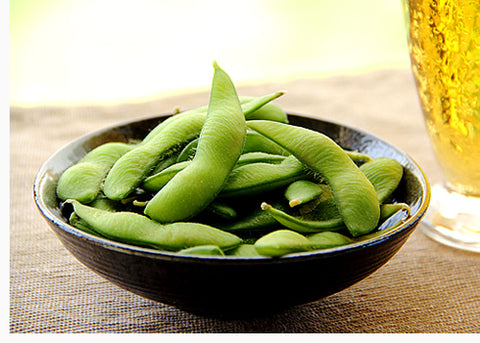EDAMAME
UNRIPE, GREEN AND DELICIOUS!

In the heart of summer, when the sun's rays are beating down relentlessly and all you want is to find a nice bit of shade (or a/c), the delicious legumes called edamame are coming into season. The light, savory taste accompanying an icy brew will whet your appetite and pull you out of the summer doldrums. Edamame is the snack of choice and practically inevitable appetizer at many izakayas and other traditional eating establishments in Japan, regardless of the season, but they have also found their way onto the family dining table. What is the story about these little green gems that everyone keeps reaching for until the bowl is empty?
JUST WHAT ARE EDAMAME
To the uninitiated, these green, slightly fuzzy, odd shaped pods don't look very tasty. And if not taught how to eat them, you may end up with a mouthful of tough, fibrous material (personal experience). Not all of us know that the pods themselves are inedible; they only house the edible portion, which is made up of tasty little green beans which are squeezed out (use your teeth or your fingers) and eaten. The word edcimcime is made up of two konji characters, edo meaning branch or twig, and mome meaning legume, or more specifically, bean in this case. Edamame, refers to the unripe soybean in its pod which is picked while still green, as well as the pod which holds the beans. lfallowed to ripen fully, the beans would develop into the soybeans (daizu in Japanese) which can then be processed for soymilk soy sauce, miso, natto etc.
The immature soybean is called edamame (in English, as well), and the mature one is called soybean. It's not clear when Japanese people began eating edamame, but it has been presumed that they were being eaten sometime during the Nara period (710-794). There also exist written references of their being presented as gifts during the Kamakura period (1 185-1333) and as snacks for alcoholic beverages during ceremonies at Buddhist temples during the Muromachi period (1337-1573).
Furthermore, there is documentation from the Edo period (1603-1868) mentioning, "ln the summertime, one can see edamame vendors peddling their goods in town," but these were still attached to the twig, then boiled and sold, unlike today where the individual pods are detached from the branch and blanched or boiled in salted water. In those days, everyone from youngsters to adults enjoyed snacking on the pods attached to the twig while strolling along, which is interesting, as the Japan of today frowns upon eating while walking along the street. From that point on, we can say that edamame was considered a type of fast food for the general populace. Originally, they were called something like "beans on a stick," but it's said that term was the precursor of the word edamame.
NUTRITIONAL VALUE
Nutritionally speaking, edamame are a combination of the good points of both legumes and vegetables; they also, like soybeans, cowtain high quality protein and lots of dietary fiber and the merits of green-yellow veggies which include a goodly amount of vitamins and carotene. The especially plentiful Vitamin B1 aids in changing sugars into energy, activating one's metabolism, and helping to protect from summer fatigue. Edamame also have immunity boosting Vitamin A, and good-for-the-skin Vitamin C. It's interesting to note that these vitamins are NOT present in the matured soybean. Edamame also help protect against menopausal symptoms and lifestyle related diseases by virtue of the isoflavones they contain. They are said to be good for brain function and concentration, as well as helping to eliminate oxygen free radicals thanks to polyphenols, and the potassium in edomome aids in the exertion of puffiness inducing sodium. What else? Edamome contain methionine, an amino acid which helps to break down alcohol and relieve the burden on the liver, as well as protect against the dreaded futsukayoi, or hangover. In short, it makes a great deal of sense that edamame should be the standard snack for summertime (or anytime) beer (or other alcoholic beverage) guzzling. Of course, edamame’s healthful qualities benefit everyone, even those who don't imbibe, helping us beat the summer fatigue brought on by summer heat, and giving our health agenda a nice power-up!
